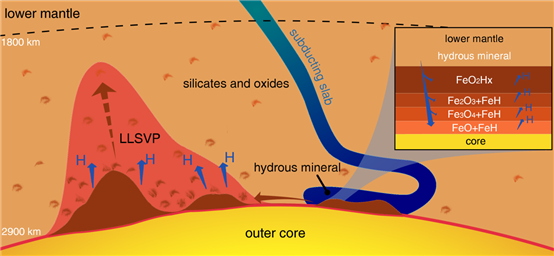Fate of water into the earth - Dr. Ho-Kwang Mao
SEPTEMBER 11, 2017
From a geoscientist’s view, the earth is made up of a giant iron core, covered by a thick layer of silicate mantle and a thin coating of crustal rocks. Water concentrates in oceans on Earth’s surface. A portion of water reacts with rocks and forms the so-called hydrous minerals that can transport deep into the mantle. Once they reach the bottom of the mantle, naturally we’ll ask the question: what will happen when water meets the iron core? A team led by Dr. Ho-Kwang Mao, director of HPSTAR published their answer to this question in the latest issue of National Science Review (DOI: 10.1093/nsr/nwx109).
“When water meets iron at the bottom of the mantle, it reacts with iron to form a highly oxidized phase”, said Dr. Mao.
The team including collaborators from HPSTAR, Geophysical Laboratory of Carnegie Institution of Washington, Stanford University, HPCAT and Chicago University, subjected a piece of iron with water under lower mantle pressure-temperature conditions (about 960,000 times atmospheric pressure, and 1900 degrees Celsius). Using synchrotron x-ray diffraction and laser heating, they discovered the formation of an oxygen rich FeO2Hx and iron hydride from the reaction.
The same phenomenon was soon observed in between the extended class of iron oxides and water. Since the earth core can provide almost inexhaustibly amount of iron, with the continuin g transportation of water into the mantle, oxygen will accumulate in FeO2Hx just above Earth’s core.
g transportation of water into the mantle, oxygen will accumulate in FeO2Hx just above Earth’s core.
The research team also finds oxygen tends to store in the form of FeO2Hx, while hydrogen will separate from water and migrate upwards.
“The accumulation of highly oxidized FeO2Hx introduces metastable domains in the mantle”, explained Dr. Mao. “Once it reaches a critical point, it will incur a large scale of oxygen eruption to Earth’s surface that possibly causes major climate change”.
Caption: The oxygen and hydrogen cycling in the deep Earth.
媒体报道:
Carnegie Science:https://carnegiescience.edu/news/when-water-met-iron-deep-inside-earth-it-might-have-created-conditions-life
ScienceDaily:https://www.sciencedaily.com/releases/2017/11/171113194954.htm
Phys.Org:https://phys.org/news/2017-11-met-iron-deep-earth-conditions.html
搜狐: http://www.sohu.com/a/204162874_343161
简单来说,地球自外而内分别由一层较薄的地壳、一层较厚的地幔和中心的大铁球地心所组成。地球表面的大洋大海中富集着大量的水,它们其中的一部分会与岩石反应生成所谓的含水矿物而进入地球内部,甚至深入地幔。当它们达到地幔底部进而遇到地心的时候,到底会发生什么样的变化?来自HPSTAR的毛河光院士带领的研究小组发现当水在地幔底部遇见铁,它们会发生化学反应生成一种高度氧化的矿物,甚至任意铁氧化物和水之间也存在类似的化学反应。由于地核可以提供接近于无限的铁,当水源源不断被输送到地幔深部,氧元素以FeO2Hx的形式在地核上部慢慢积聚。同时他们发现当氧元素积聚的同时,氢元素则从水中分离出来并最终回到地球表面。高度氧化的FeO2Hx在地幔中是不稳定的,当它到达一个临界点的时候,可能会爆发大面积的氧气爆发,最终导致地球表面的气候变化。
